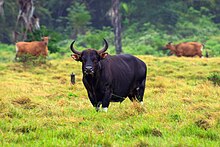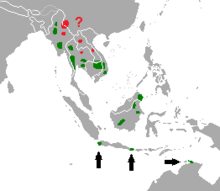| Banteng | |
|---|---|

| |
| Scientific classification | |
| Domain: | Eukaryota |
| Kingdom: | Animalia |
| Phylum: | Chordata |
| Class: | Mammalia |
| Order: | Artiodactyla |
| Family: | Bovidae |
| Subfamily: | Bovinae |
| Genus: | Bos |
| Species: | B. javanicus
|
| Binomial name | |
| Bos javanicus d'Alton, 1823
| |
| Subspecies | |
|
List
| |

| |
| Distribution of banteng (2010)[2] green: present red: possibly present | |
| Synonyms[3][4] | |
|
list
| |
The banteng (Bos javanicus; /ˈbæntɛŋ/), also known as tembadau,[5] is a species of wild bovine found in Southeast Asia.
The head-and-body length is between 1.9 and 3.68 m (6.2 and 12.1 ft).[6] Wild banteng are typically larger and heavier than their domesticated counterparts, but are otherwise similar in appearance. The banteng shows extensive sexual dimorphism; adult bulls are generally dark brown to black, larger and more sturdily built than adult cows, which are thinner and usually pale brown or chestnut red. There is a big white patch on the rump. Horns are present on both sexes, and are typically 60 to 95 cm (24 to 37 in) long. Three subspecies are generally recognised.
Banteng are active during the day as well as at night, though activity at night is more in areas frequented by humans. Herds comprise two to forty individuals, and generally a single bull. Being herbivorous, banteng feed on vegetation such as grasses, sedges, shoots, leaves, flowers, and fruits. Banteng can survive without water for long stretches during droughts, but drink regularly if possible, especially from standing water. Not much is known about the reproductive physiology of banteng, but it might be similar to that observed in taurine cattle. After a gestation of nearly 285 days (nine to ten months), a week longer than that typically observed in taurine cattle, a single calf is born. Banteng occur in a variety of habitats throughout their range, including open deciduous forests, semi-evergreen forests, lower montane forests, grasslands, and abandoned farms.
The largest populations of wild banteng occur in Java, Cambodia, and possibly in Kalimantan (particularly East Kalimantan and North Kalimantan) and Thailand. Domesticated banteng occur in Bali and many eastern Indonesian islands (such as Sulawesi, Sumbawa, and Sumba), Australia, Malaysia, and New Guinea. Feral populations are found in Sabah and the Northern Territory of Australia. Domesticated populations are primarily used for their highly demanded meat, and are used as draught animals to a lesser extent. The wild banteng is classified as Endangered on the IUCN Red List, and populations have decreased by more than 50% in the past few decades. Rampant poaching (for food, game, traditional medicine and horns), habitat loss and fragmentation and susceptibility to disease are major threats throughout its range. Wild banteng are legally protected in all countries in their range, and are largely restricted to protected areas (possibly barring Cambodia). The banteng is the second endangered species to be successfully cloned, and the first clone to survive beyond infancy.
- ^ K. Suraprasit, J.-J. Jaegar, Y. Chaimanee, O. Chavasseau, C. Yamee, P. Tian, and S. Panha (2016). "The Middle Pleistocene vertebrate fauna from Khok Sung (Nakhon Ratchasima, Thailand): biochronological and paleobiogeographical implications". ZooKeys (613): 1–157. Bibcode:2016ZooK..613....1S. doi:10.3897/zookeys.613.8309. PMC 5027644. PMID 27667928.
{{cite journal}}: CS1 maint: multiple names: authors list (link) - ^ a b Gardner, P.; Hedges, S.; Pudyatmoko, S.; Gray, T.N.E.; Timmins, R.J. (2024). "Bos javanicus". IUCN Red List of Threatened Species. 2024: e.T2888A256426742. doi:10.2305/IUCN.UK.2024-2.RLTS.T2888A256426742.en.
- ^ Cite error: The named reference
msw3was invoked but never defined (see the help page). - ^ Cite error: The named reference
hooijerwas invoked but never defined (see the help page). - ^ Cite error: The named reference
philwas invoked but never defined (see the help page). - ^ Cite error: The named reference
Hoogerwer1970was invoked but never defined (see the help page).
